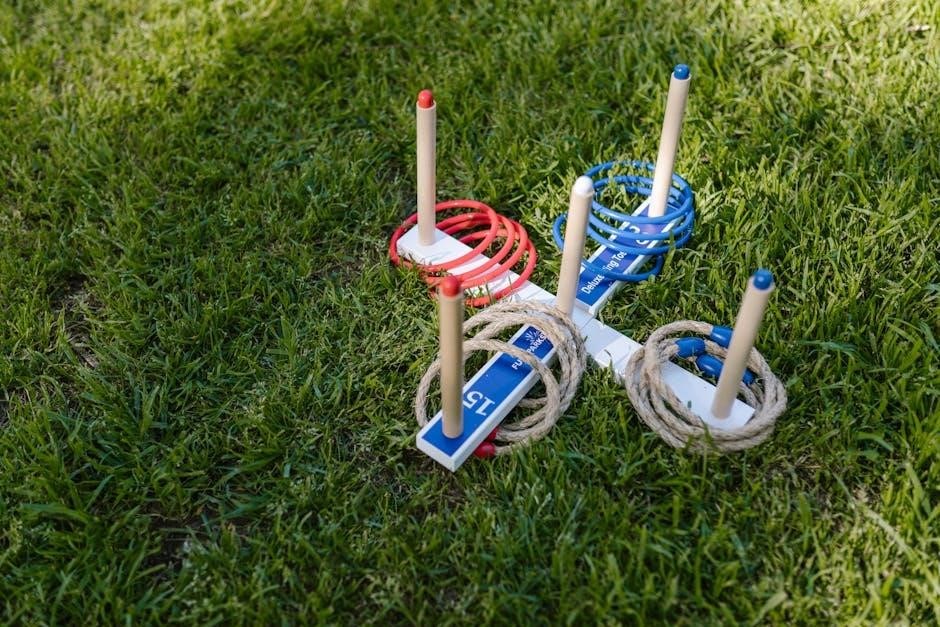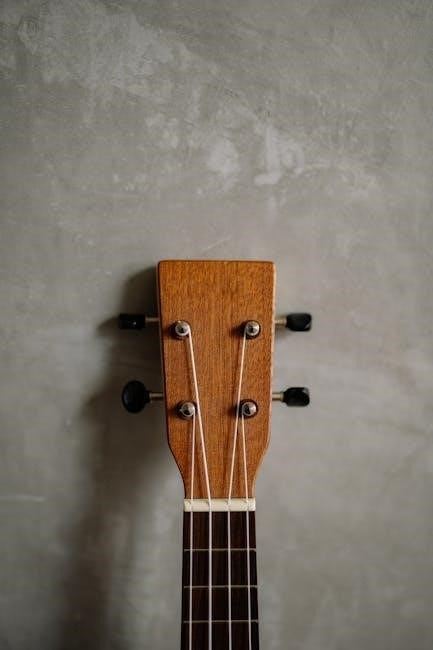Pegs and Jokers is an American game where players move pegs or marbles around a board using playing cards‚ including Jokers‚ aiming to be the first to reach the SAFE area.
Overview of the Game
Pegs and Jokers is a dynamic card-and-board game where players move pegs or marbles around a specially designed board. The game is typically played in teams‚ with 4 to 8 players divided into teams of two. Each team uses a unique set of colored pegs‚ and the objective is to move all pegs clockwise around the board to the “SAFE” area. The game combines strategy with luck‚ as players use standard playing cards (with Jokers included) to determine moves. Cards from 2 to 10 allow players to move forward‚ while face cards and Aces have special rules. Jokers are wild cards‚ enabling players to move any peg or disrupt opponents. The game is known for its balance of skill and chance‚ making it enjoyable for both casual and competitive players. Its adaptable rules allow for variations in team sizes and board setups‚ ensuring flexibility for different group preferences.
The primary goal in Pegs and Jokers is to be the first team or individual to move all of their pegs into the “SAFE” area‚ completing the race around the board. Players must strategically use their cards to navigate their pegs clockwise‚ overcoming challenges and opponents along the way. Each card played determines how many spaces a peg can advance‚ with special rules for face cards‚ Aces‚ and Jokers adding layers of strategy. Teams or players must balance advancing their own pegs while potentially hindering their opponents. The game ends as soon as one team successfully moves all their pegs into the SAFE zone‚ securing victory. This objective requires a mix of tactical card play and luck‚ making the game both competitive and engaging for participants. The race to the finish ensures every move counts‚ keeping players on the edge until the final peg is safely home. Setup involves game boards‚ pegs‚ and card decks with Jokers. The number of boards and decks varies based on players‚ ensuring each team has uniquely colored pegs for clarity. Pegs and Jokers supports various player configurations‚ accommodating 4‚ 6‚ or 8 players. Teams are typically formed in pairs‚ with two-person teams being common. For every two players‚ an additional deck of cards is added to ensure smooth gameplay. Larger groups can form three-person teams‚ allowing for more dynamic interactions. The flexibility in team sizes makes the game accessible to different social settings‚ whether it’s a small gathering or a larger event. Teams often sit opposite each other‚ promoting strategic collaboration and competition. The game’s adaptability ensures that it remains engaging regardless of the number of participants‚ making it a versatile option for diverse groups of players. The game requires a special board where players move their pegs clockwise. Each player selects five pegs of a unique color‚ ensuring easy identification during play. The board features distinct spaces‚ including a start area and a SAFE position‚ which is the goal for all pegs. Players arrange their pegs in their respective start spaces at the beginning. The board’s design allows for strategic movement‚ with certain spaces designated for specific actions‚ such as “come-out” for starting pegs. The SAFE area is the final destination‚ where all pegs must be positioned to win. While store-bought boards are available‚ players can also create their own boards‚ adding a personal touch to the game. The setup ensures fair play‚ with each player’s pegs clearly separated and visible throughout the game. The game utilizes standard poker card decks with specific configurations. For every two players‚ one deck of 24 cards is used‚ including Jokers. Each deck typically contains two Jokers‚ which play a crucial role in gameplay. Jokers can be used strategically to move pegs or disrupt opponents. The number of decks increases with more players‚ ensuring sufficient cards for all participants. Cards from 2 to 10 determine the number of moves‚ while Jokers can either move a peg forward 10 spaces or allow a player to bring a peg out of the start area. Aces are also included‚ offering a unique movement option. The deck is shuffled and dealt equally among players‚ forming their hands. Proper management of the card deck is essential‚ as it dictates the flow of the game and the strategies employed by players to outmaneuver their opponents. Players move pegs clockwise using cards 2-10 for corresponding moves. Jokers allow special actions‚ like moving 10 spaces or bringing pegs out. Each turn‚ a card must be played to advance. In Pegs and Jokers‚ cards 2 through 10 correspond to the number of spaces a peg can move forward. Face cards (Jack‚ Queen‚ King) and Aces have unique roles‚ such as moving a peg backward or allowing it to exit the start position. Jokers are wildcards‚ enabling players to move any peg 10 spaces or bring a peg out of the starting area. Players must play a card each turn‚ and the card’s value determines the movement. If a peg lands exactly on an opponent’s peg‚ it can send the opponent’s peg back to the start. Movement is strictly clockwise‚ and a peg cannot move onto or past another peg of the same color. Strategic use of Jokers and high-value cards is crucial for advancing quickly and outmaneuvering opponents. Understanding card values and their effects is essential for mastering the game. Each player selects five uniquely colored pegs‚ which must be moved clockwise around the board. A peg cannot move onto or past another peg of the same color but can bypass pegs of different colors. Landing exactly on an opponent’s peg allows the player to send that peg back to its starting position. Pegs must be moved out of the start position using an Ace or a Joker. Once all pegs are in the SAFE area‚ the game is won. Players must use the correct card values to advance pegs‚ and strategic movement is key to success. Special rules ensure fair play and add complexity to the game‚ making it both challenging and enjoyable for participants. Understanding these rules is crucial for effective gameplay and achieving victory. Proper application of these rules ensures a balanced and competitive experience for all involved. Adhering to these guidelines enhances the overall enjoyment of Pegs and Jokers. Winning the game requires being the first team or individual to move all of their pegs into the SAFE position. The SAFE area is a designated zone on the board where pegs are protected from being sent back. Teams or players must strategically use their cards to advance their pegs while hindering opponents. The game ends immediately when all pegs of a team or player are safely positioned. Victory is achieved through a combination of efficient card play and clever blocking of opponents. The first to secure all pegs in the SAFE area is declared the winner‚ making it a race against time and strategy. Proper planning and skillful use of Jokers can significantly accelerate progress toward the goal. The game concludes as soon as the winning condition is met‚ ensuring a competitive and exciting finale for all participants involved. Timing and precision are key to securing victory in Pegs and Jokers. Mastering Pegs and Jokers requires skillful Joker usage and strategic blocking. Using Jokers to bypass obstacles and block opponents effectively can significantly enhance your chances of winning the game quickly. Jokers are powerful wild cards in Pegs and Jokers‚ allowing players to move any peg forward 1-10 spaces or bypass obstacles. Use them strategically to advance your pegs toward the SAFE area or block opponents. Timing is crucial; saving Jokers for critical moments can change the game’s outcome. For example‚ a Joker can rescue a peg stuck behind others or push it closer to safety. Always consider your opponents’ moves to maximize the Joker’s impact. Effective Joker usage can make the difference between winning and losing‚ especially in tight races. Plan ahead and use these versatile cards wisely to outmaneuver your opponents and secure victory. Blocking opponents is a strategic aspect of Pegs and Jokers‚ where players can hinder others’ progress to gain an advantage. By positioning your pegs strategically‚ you can create barriers that slow down opponents. For instance‚ moving a peg to a spot directly in front of an opponent’s peg can prevent them from advancing. Additionally‚ using high-value cards to jump over opponents’ pegs can disrupt their momentum. Jokers can also be used to send opponents’ pegs back to the start‚ providing an effective way to delay their progress. Timing these moves carefully is essential‚ as it can significantly impact the game’s outcome. Mastering the art of blocking requires a balance between advancing your own pegs and disrupting your opponents‚ ensuring you stay ahead in the race to the SAFE area. Pegs and Jokers is a strategic and thrilling game requiring skill and luck. Mastering the rules and optimizing card use ensures a fun and competitive experience for all players. To excel in Pegs and Jokers‚ plan strategically and manage your cards wisely. Use Jokers to overcome obstacles or gain an advantage; Always aim to block opponents while advancing your pegs. Observing other players’ moves can provide valuable insights. Keep your pegs evenly spaced to avoid congestion and ensure smooth progress. Prioritize moving pegs closer to the finish line to secure an early win. Defense is as important as offense—use high-value cards to protect your pegs from being sent back. Finally‚ adapt your strategy based on the game’s flow and your opponents’ tactics. Balancing luck with skill will lead to consistent success in this engaging game.Objective of the Game

Setup and Materials

Number of Players and Teams

Game Boards and Pegs

Card Decks and Jokers
Basic Rules of Play
Card Values and Movements

Special Rules for Pegs
Winning the Game

Advanced Strategies
Using Jokers Effectively
Blocking Opponents
Final Tips for Success